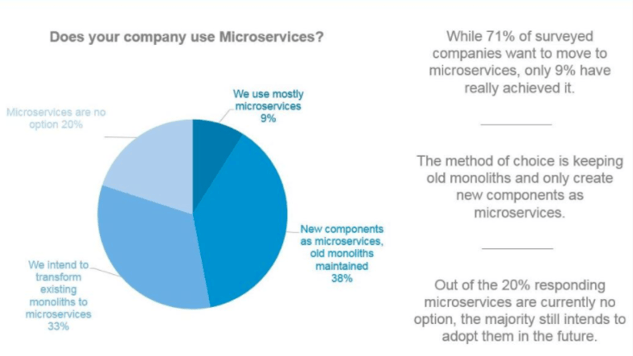
In a recently published article on cio.de, LeanIX was mentioned due to our study on Microservices. Here is a translation of the complete exposé:
Many companies want to increase their usage of Microservices in 2017 to break up their monolithic systems and deploy faster, but in practice, there are still many challenges to overcome.
More than 70 percent of companies want to intensify their usage of Microservices in 2017. This was the conclusion that the Bonn-based software company LeanIX came to after conducting a study amongst more than 100 IT experts of European and American enterprises. “The result is impressive”, explained André Christ, founder, and co-CEO of LeanIX. “Companies that use Microservices offer their clients new functions much more frequently”.

The ability to deploy new releases multiple times per week, gives companies an incredible advance, as they can react much better to their clients’ needs and to market changes. The study proved that, with the help of Microservices, new weekly releases quadrupled.
Even though, many companies have not put Microservices into practice yet. Only 17 percent of companies currently release weekly deploys. For 51 percent of studied companies, the standard release cycle is a few times per year, while ¼ of companies deploy monthly releases.
Amazon, Netflix, and Zalando bet on Microservices.
Internet companies such as Netflix, Amazon, or Zalando have been betting a while now on Microservices. Behind this lies principally the promise of a Service-Oriented Architecture (SOA): Organizations should slowly break up their monolithic systems by implementing new functions only as Microservices.
“When using a Microservice Architecture, application architectures can be modeled and new functions can be added easier and faster,” says René Büst, who worked until the end of 2016 for the analyst company “Crisp Research” and today is responsible for the software firm Arago. A Microservice represents a completed functionality and is developed and run independently. Büst: “It is about a small, independent software component, which has a small function in a big, distributed software application.
Big Cloud providers have already brought Microservices into their portfolios. An example of this type of granular service is Microsoft’s Azure Notification Hub or Azure Scheduler. Amazon offers services such as Route 53 or Amazon SQS. Companies can use these types of services to develop a cloud-native application, explains Büst.
Microservices promote Digitization
For software expert and consultant Marina Ribke, Microservices are “the answer to the challenges of Digitization in relation to flexibility and availability”. Whoever wants to introduce them, needs to “rethink” IT. Marina thinks that Microservices make sense there where fast and agile changes are especially important. This is especially significant for business functionalities which are essential for market differentiating. But here also lies the crux of the problem. “To implement new architecture means also a bigger risk of errors and exceptions. This is what one wants to avoid with market differentiating functionalities. This is why it is recommended to start with small functions, whose possible malfunction is bearable.
Practical implementation is still hard for companies
It is a fact that many companies still face hurdles when it comes to the practical implementation of a Microservice strategy. According to LeanIX’s study, only nine percent of companies have dared to adopt Microservices. In most cases, the companies maintain their old monolithic software and only implement new components as microservices. Even though, a third of the IT-Managers plan to transform existing software systems into Microservices. Only twenty percent say that this concept is not a viable option.
The biggest hurdles amongst the interviewed IT-Managers are a lack of know-how and missing experts. Legacy processes are also a challenge when it comes to these new projects. One-fifth of the interviewed people claimed a higher complexity as a reason for this.
/EN/Reports/EN-LX-DevOp-Exp-Survey-Resource-Page-Thumbnail.png?width=140&height=99&name=EN-LX-DevOp-Exp-Survey-Resource-Page-Thumbnail.png)


